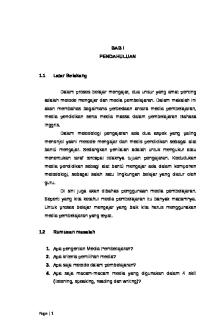BAHASA INGGRIS UNTUK BIOLOGI PDF

| Title | BAHASA INGGRIS UNTUK BIOLOGI |
|---|---|
| Author | Trisna Amelia |
| Pages | 75 |
| File Size | 1.7 MB |
| File Type | |
| Total Downloads | 43 |
| Total Views | 119 |
Summary
BAHASA INGGRIS UNTUK BIOLOGI i ii BAHASA INGGRIS UNTUK BIOLOGI TRISNA AMELIA NUR EKA KUSUMA HINDRASTI iii Perpustakaan Nasional: Katalog Dalam Terbitan © Trisna Amelia, Nur Eka Kusuma Hindrasti, 2016 Bahasa Inggris untuk Biologi Trisna Amelia Nur Eka Kusuma Hindrasti Hak cipta dilindungi Undang-Unda...
Description
BAHASA INGGRIS UNTUK BIOLOGI
i
ii
BAHASA INGGRIS UNTUK BIOLOGI
TRISNA AMELIA NUR EKA KUSUMA HINDRASTI
iii
Perpustakaan Nasional: Katalog Dalam Terbitan
© Trisna Amelia, Nur Eka Kusuma Hindrasti, 2016
Bahasa Inggris untuk Biologi Trisna Amelia Nur Eka Kusuma Hindrasti
Hak cipta dilindungi Undang-Undang. Dilarang mengutip sebagian atau seluruh isi buku ini dengan cara apa pun, termasuk dengan cara penggunaan mesin fotokopi, tanpa ijin sah dari penerbit ISBN 978-602-6770-07-3 vii, 68 hlm, 17,6 cm X 25 cm Cetakan 1, Oktober 2016
Hak Penerbitan pada UMRAH Press, Tanjungpinang
Kantor: Kampus Universitas Maritim Raja Ali Haji, Gedung Rektorat Lantai III Jl. Dompak, Tanjungpinang, Provinsi Kepulauan Riau 29111 Telp/Fax : (0771) 7001550 – (0771) 7038999, 4500091 E-mail : [email protected] / [email protected]
iv
PREFACE
Thank Allah SWT who has given His bless to the writer for finishing the Book entitled “Bahasa Inggris untuk Biologi”. The writer also wish to express his deep and sincere gratitude for those who have guided in completing this book. This book contains concept of biology and the exercise in English language that can help the readers to improve their English skill in biology. There are eight main contents in this book, which are the chemistry of life, an introduction of metabolisms, biotechnology, mechanisms of evolution, classification of living things,reproduction in plant, thermoregulation, and ecology. Hopefully, this book can help the readers to expand their knowledge about English for Biology.
Tanjungpinang, September 2016
Authors
v
CONTENTS
Preface
……………………………….
i
Contents
……………………………….
ii
Chapter 1 INTRODUCTION
……………………………….
1
Chapter 2 THE CHEMISTRY OF LIFE
……………………………….
5
Chapter 3 AN INTRODUCTION OF
……………………………….
9
Chapter 4 BIOTECHNOLOGY
……………………………….
14
Chapter 5 MECHANISMS OF
……………………………….
18
……………………………….
22
Chapter 7 REPRODUCTION IN PLANT
……………………………….
31
Chapter 8 THERMOREGULATION
……………………………….
39
Chapter 9 ECOLOGY
……………………………….
49
Bibliography
……………………………….
61
Glossary
……………………………….
62
Index
……………………………….
66
METABOLISMS
EVOLUTION Chapter 6 CLASSIFICATION OF LIVING THINGS
vi
vii
Chapter I INTRODUCTION 1. Deskripsi Mata Kuliah Mata kuliah bahasa inggris untuk biologi dirancang untuk memberi bekal mahasiswa agar dapat menguasai bahasa Inggris dalam menunjang pemahaman ilmu kimia dari literatur atau sumber informasi berbahasa Inggris. Materi perkuliahan mencakup peningkatan literasi dalam memahami naskah saintifik berbahasa inggris. Latihan-latihan yang diberikan berorientasi pada hakikat sains, terutama keterampilan proses sains. Adapun konten materi yang terkandung, di antaranya the chemistry of life, an introduction of metabolisms, biotechnology, mechanisms of evolution, classification of living things,reproduction in plant, thermoregulation, dan ecology. Bahasa inggris digunakan sebagai pengantar perkuliahan. Penilaian diambil dari partisipasi dan keaktifan mahasiswa dalam perkuliahan. 2. Standar Kompetensi Mahasiswa mampu menerapkan keterampilan proses sains untuk memahami teks saintifik berbahasa inggris. 3. Kompetensi Dasar a. Mahasiswa mampu memahami teks saintifik berbahasa inggris b. Mahasiswa mampu menerapkan keterampilan proses sains dengan pengantar bahasa inggris.
1
SYLLABUS Mata Kuliah Bahasa Inggris untuk Biologi
Description of the Course
Objrectives of the Course
Wee Topic k 1 An Introduction to course outline 2 The Chemistry Of Life
3
An Introduction
Code PB1116
SKS 2
Semester Odd
Lecturers Trisna Amelia, M.Pd. Nur Eka Kusuma Hindrasti
English for Biology is English for Specific Purposes ( ESP), English for Academic Purposes (EAP) and English for Professional Purposes (EPP) toilored to the needs of first and second semester undergraduate Biology Education Department at FKIP UMRAH. The aim of this course is to accomplish student with english ability and make then capable in science process skill. The course materials include reading comprehension, structure, speaking , and listening, from the chosen topics related biology and teaching biology. 1. Answer the questions from the texts related to biology topics. 2. Use the biology terms in sentences. 3. Speak English in academic context. 4. Use classroom languages. 5. Write composition
Objectives 1.
To get familiar with its objectives of the course 2. To introduce one sefl in English
Sourc e Syllabu s
Time 2 x 50‟
1. Explain the concept of the chemistry of life 2. Raising question about the chemistry of life 3. Explain the structural polysaccharides 4. Communicate the different of the structure chitin and cellulose monomer through pictures and explanations 5. Apply the concept of structural polysaccharides to a operation in hospital 6. Predict a phenomenon
Module Chapte r1
2 x 50‟
1. define the concept of metabolisms 2. Raise question about metabolisms 3. Explain respiration and photosyntesize
Module Chapte r2
2 x 50‟
2
Wee k
Objectives
Sourc e
Time
An Introduction Of Metabolisms
1. Ask question about photosyntesize 2. Design experiment about photosyntesize 3. Contruct a table of data
Module Chapte r2
2 x 50‟
Biotechnolog
1. 2. 3. 4.
Define biotechnology Raising question about biotechnology Define genetic engineering Aski uestion about genetic engineering
Module Chapte r3
2 x 50‟
1. Construct hypotheses from the question 2. Design a investigation based on hypotheses 3. Predict about genetic engineering 4. Communicate the results of the investigation to the poster 1. Define evolution 2. Ask question about evolution 3. Define natural selection 4. Construct a graph based on the data 5. Construct hypotheses from the phenomenon 6. Predict an explanation from the phenomenon
Module Chapte r3
2 x 50‟
Module Chapte r4
2 x 50‟
1.
Module Chapte r5
Topic Of Metabolisms
4
5
y
6
Biotechnolog y
7
Mechanisms Of Evolution
8 9
10
11
Mid-Exam The classification of Living Things The classification of Living Things Thermoregul ation
12
Thermoregul ation
13
Reproductio
2. 1. 2. 1.
raise a question about the concept Classification of Living Things; analyze the advantageous of classification system in living things; define the system of classification of living things; applying the concept about Classification of Living Things Raise a question about thermoregulation; Define thermoregulation; Define endothermy and ectothermy;
2. 3. 4. 1. Interpret data about thermoregulation; 2. Applying concept about thermoregulation 1.
Raise a question about reproduction in plant; 2. define reproduction;
2 x 50‟ 2 x 50‟
Module Chapte r5
2 x 50‟
Module Chapte r6
2 x 50‟
Module Chapte r6
2 x 50‟
Module Chapte r7
2 x 50‟
3
Wee k
Topic n In Plant
14
Ecology
15
Ecology
16
FINAL EXAM
Objectives 3. differentiate between vegetative, asexual and sexual reproduction; 4. explain the parts of a dicot flower and their functions; 5. present the part of a dicot flower; 6. observe a dicot flower and determine each part of the flower; 7. state the types of pollination.; 1. define ecology and describe the major sub-disciplines: behavior, population ecology, community ecology; 2. identify factor that determine geographic distribution; 3. identify biotic and abiotic factor; 1. define ecosystem; 2. define primary producer, primary consumer, secondary consumer, and omnivory and be able to accurately identify these in a food web; 3. read and interpret a food web diagram with multiple trophic levels and how these interact using top-down and bottom-up terminology; 4. interpret food chains and food webs, and be able to locate a food chain within a food web.
Sourc e
Time
Module Chapte r8
2 x 50‟
Module Chapte r8
2 x 50‟
2 x 50‟
Tanjungpinang, August 2016 Lecturers
Trisna Amelia, M.Pd. Nur Eka Kusuma Hindrasti, M.Pd.
4
Chapter II THE CHEMISTRY OF LIFE OBJECTIVES After completing this lesson, you will be able to : 7. Explain the concept of the chemistry of life 8. Raising question about the chemistry of life 9. Explain the structural polysaccharides 10. Communicate the different of the structure chitin and cellulose monomer through pictures and explanations 11. Apply the concept of structural polysaccharides to a operation in hospital 12. Predict a phenomenon
The flower above is from a magnolia, a tree of ancient lineage that is native to Asian and American forests. The magnolia blossom is a sign of the plant's status as a living organism, for flowers contain organs of sexual reproduction, and reproduction is a key property, as you will learn later. Like all organisms, the magnolia tree in second figure above is living in close association with other organisms, though it is a lone specimen far from its ancestral forest. For example, it depends on beetles to carry pollen from one flower to another, and the beetles, in turn, eat from its flowers. The flowers are adapted to the beetles in several ways: Their bowl shape allows easy access, and their multiple reproductive organs and tough petals help ensure that some survive the voracious beetles. Such adaptations are the result of evolution, the process of change that has transformed life on Earth from its earliest beginnings to the diversity oforganisms living today. As
5
discussed later in this chapter, evolution is the fundamental organizing principle of biology and the main theme of this book. Although biologists know a great deal about magnolias and other plants, many mysteries remain. For instance, what exactly led to the origin of flowering plants? Posing questions about the living world and seeking science-based answers scientific inquiry are the central activities of biology, the scientific study of life. Biologists' questions can be ambitious. They may ask how a single tiny cen becomes a tree or a dog, how the human mind works, or how the different forms of life in a forest interact. Can you think ofsome questions about living organisms that interest you? When you do, you are already starting to think like a biologist. More than anything else, biology is a quest, an ongoing inquiry about the nature of life. Perhaps some of your questions relate to health or to societal or environmental issues. Biology is woven into the fabric of our culture more than ever before and can help answer many questions that affect our lives. Research breakthroughs in genetics and cell biology are transforming medicine and agriculture. Neuroscience and evolutionary biology are reshaping psychology and sociology. New models in ecology are helping societies evaluate environmental issues, such as global warming. There has never been a more important time to embark on a study of life. EXERCISE A. Raising Questioning Based to the text, raise a question about the chemistry of life, next find what the answer is? Question
:
.............................................................................................................................................. .... Answer
:
.............................................................................................................................................. .............................................................................................................................................. ...... STRUCTURAL POLYSACCHARIDES Carbohydrates include both sugars and polymers of sugars. The simplest carbohydrates
are
the
monosaccharides,
also
known
as
simple
sugars.
Monosaccharides (from the Greek monos, single, and sacchar, sugar) generally have molecular formulas that are some multiple of the unit CH20.
6
Glucose (C6HI20 6), the most common monosaccharide, is of central in the chemistry of life. Sugar molecules are generally incorporated as monomers into disaccharides or polysaccharides. There are two polysaccharides, storage polysaccharides and structural polysaccharides Organisms build strong materials from structural polysaccharides. For example, the polysaccharide called cellulose is a major component of the tough walls that enclose plant cells. On a global scale, plants produce almost 1014 kg (100 billion tons) of cellulose per year; it is the most abundant organic compound on Earth. Some prokaryotes can digest cellulose, breaking it down into glucose monomers. A cow harbors cellulose digesting prokaryotes in its rumen, the first compartment in its stomach. The prokaryotes hydrolyze the cellulose of hay and grass and convert the glucose to other nutrients that nourish the cow. Similarly, a termite, which is unable to digest cellulose by itself, has prokaryotes living in its gut that can make a meal of wood. Some fungi can also digest cellulose, thereby helping recycle chemical elements within Earth's ecosystems Another important structural polysaccharide is chitin, the carbohydrate used by arthropods (insects, spiders, crustaceans, and related animals) to build their exoskeletons. An exoskeleton is a hard case that surrounds the soft parts of an animal. Pure chitin is leathery and flexible, but it becomes hardened when encrusted with calcium carbonate, a salt. Chitin is also found in many fungi, which use this polysaccharide rather than cellulose as the building material for their cell walls. Chitin is similar to cellulose, except that the glucose monomer of chitin has a nitrogen. EXERCISE B Communicate through pictures and explanations As we know from the paragraph above, chitin is similar to cellulose, except that the glucose monomer of chitin has a nitrogen. Know, please communicate to your friend by picture how the different of chitin and cellulose structure is, and than explain them!
7
The structure of the chitin monomer. EXERCISE C Apply the concept
The structure of the cellulose monomer.
Have you ever get a operation in hospital? Usually you must be surgic for cover the pain. Do you know surgical thread is made from? Know, looking for a knowledge what surgical thread is made from and how is they work!
EXERCISE D Predict Predict, What would happen if a cow were given antibiotics that killed all the prokaryotes in its stomach? Answer: .............................................................................................................................................. ................................................................................................................................
8
Chapter III AN INTRODUCTION OF METABOLISMS OBJECTIVES After completing this lesson, you will be able to : 4. define the concept of metabolisms 5. Raise question about metabolisms 6. Explain respiration and photosyntesize 7. Ask question about photosyntesize 8. Design experiment about photosyntesize 9. Contruct a table of data
The living cell is a chemical factory in miniature, where thousands of reactions occur within a microscopic space. Sugars can be converted to amino adds that are linked together into proteins when needed, and proteins are dismantled into amino acids that can be converted to sugars when food is digested. Small molecules are assembled into polymers, which may be hydrolyzed later as the needs of the cell change. In multicellular organisms, many cells export chemical products that are used in other parts of the organism. The process known as cellular respiration drives the cellular economy by extracting the energy stored in sugars and other fuels. Cells apply this energy to perform various types of work, such as the transport of solutes across the plasma membrane. In a more exotic example, cells of the fungus in figure above convert the energy stored in certain organic molecules to light. a process called bioluminescence. (The glow may attract insects that benefit the fungus by dispersing its spores.) Bioluminescence and all other metabolic activities carried out by a cell are precisely coordinated and controlled. In its complexity, its efficiency, its integration, and its responsiveness to subtle changes, the cell is peerless as a chemical factory. The
9
concepts of metabolism that you learn in this chapter will help you understand how matter and energy flow during life's processes and how that flow is regulated. .EXERCISE A. Raising Questioning Based to the text, raise a question about An introduction of metabolisms, next find what the answer is? Question
:
...................................................................................................................................... Answer : ...................................................................................................................................... THE NEED FOR ENERGY AUTOTROPHS AND HETEROTROPHS A chemical reaction either release energy (i.e. exothermic) or uses energy (i.e. is endothermic). Almost all the chemical reactions that occur in living organisms are of the endothermic type, and this explains why organisms need a source of energy if they are to function well and stay alive. In other words, energy is the capacity to do work and the work that must be done in an organisms is to make endothermic reactions take place. In fact, we find that all organisms, both plants and animal, obtain the energy needed for endothermic reactions by oxidizing (or „burning‟) substances such as sugars.this process is called respiration: A sugar + oxygen water+carbon dioxide+energy We must now ask where an organism obtains substance like sugars All green plants can synthesize organic subtances from carbon dioxide and water, the presence of chlorophyll enabling them to utilize light energy for this endothermic process, which is called photosynthesis: Carbon dioxide + water + energy a sugar + oxygen Green plants, then, are autotrophic, as also are certain blue-green algae which lack chlorophyll. Such plants are chemosynthetic (or chemo-autotrophic) rather than photosynthetic (or photo-autotrophic), because they use energy that is released from simple exothermic chemical reactions. Beggiatoa, for example, is able to oxidize hydrogen sulphide and then use the energy that is released to synthesize sugars: Step one: hydrogen sulphide + oxygen water + sulphur + energy Step two: hydrogen + oxygen + carbon dioxide + energy a sugar + water
10
Chemosynthesis i...
Similar Free PDFs

BAHASA INGGRIS UNTUK BIOLOGI
- 75 Pages

BAHASA INGGRIS
- 10 Pages
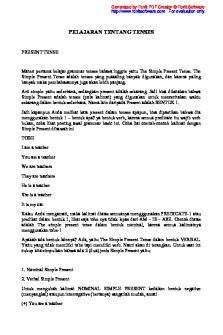
16 tenses bahasa inggris
- 27 Pages
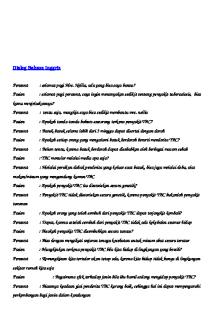
Dialog Bahasa Inggris
- 4 Pages

SKKD BAHASA INGGRIS SMK
- 3 Pages

MAKALAH PEMBELAJARAN BAHASA INGGRIS
- 57 Pages
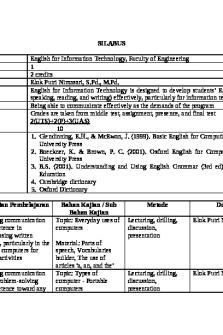
SILABUS BAHASA INGGRIS TI
- 4 Pages
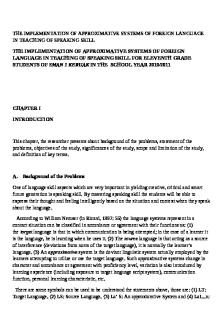
CONTOH SKRIPSI BAHASA INGGRIS
- 24 Pages

CBR bahasa inggris bisnis
- 24 Pages

Ujian Wacana Bahasa Inggris
- 5 Pages

Tugas bahasa inggris
- 1 Pages

RPP BAHASA INGGRIS
- 8 Pages
Popular Institutions
- Tinajero National High School - Annex
- Politeknik Caltex Riau
- Yokohama City University
- SGT University
- University of Al-Qadisiyah
- Divine Word College of Vigan
- Techniek College Rotterdam
- Universidade de Santiago
- Universiti Teknologi MARA Cawangan Johor Kampus Pasir Gudang
- Poltekkes Kemenkes Yogyakarta
- Baguio City National High School
- Colegio san marcos
- preparatoria uno
- Centro de Bachillerato Tecnológico Industrial y de Servicios No. 107
- Dalian Maritime University
- Quang Trung Secondary School
- Colegio Tecnológico en Informática
- Corporación Regional de Educación Superior
- Grupo CEDVA
- Dar Al Uloom University
- Centro de Estudios Preuniversitarios de la Universidad Nacional de Ingeniería
- 上智大学
- Aakash International School, Nuna Majara
- San Felipe Neri Catholic School
- Kang Chiao International School - New Taipei City
- Misamis Occidental National High School
- Institución Educativa Escuela Normal Juan Ladrilleros
- Kolehiyo ng Pantukan
- Batanes State College
- Instituto Continental
- Sekolah Menengah Kejuruan Kesehatan Kaltara (Tarakan)
- Colegio de La Inmaculada Concepcion - Cebu


